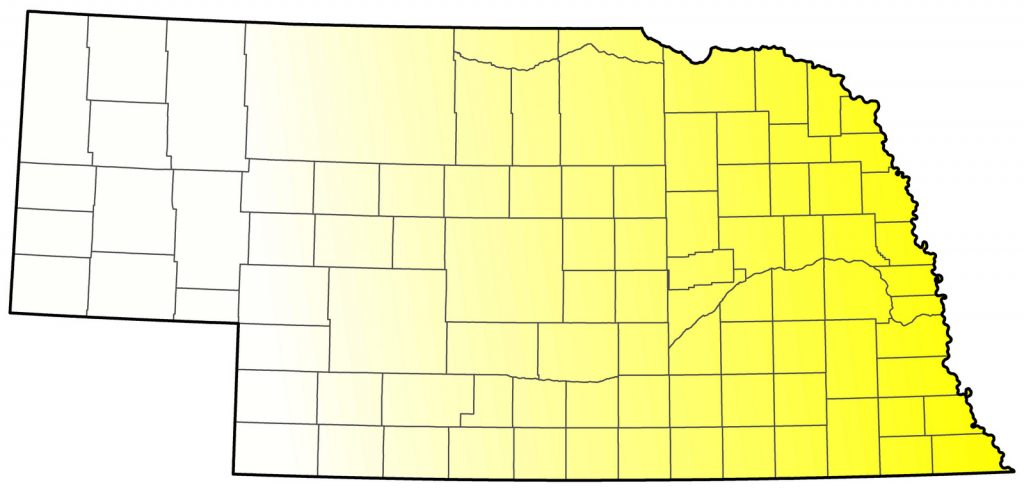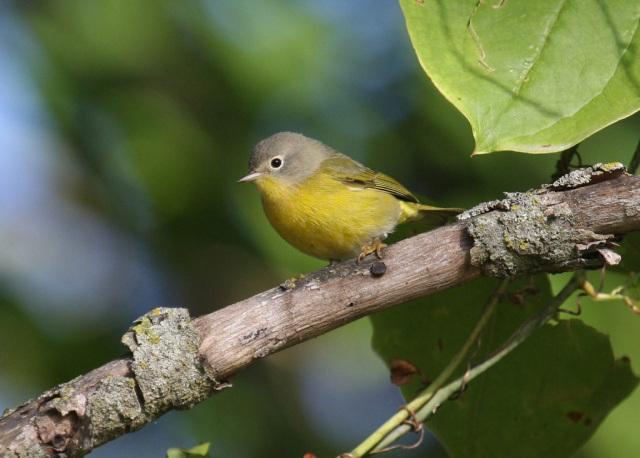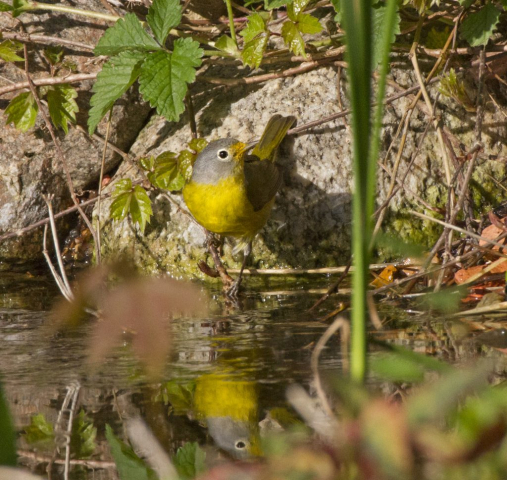Leiothlypis ruficapilla ruficapilla
Status: Common regular spring migrant east, fairly common east central, rare casual west central and west. Common fall migrant east and central, rare west.

Documentation: Specimen: ruficapilla, UNSM ZM6804, 4 May 1904 Falls City, Richardson Co.
Taxonomy: Two subspecies are recognized (AviList 2025): ridgwayi, breeding from southern British Columbia to northwest Montana and south-central California, and ruficapilla, breeding from Manitoba to Newfoundland to montane Wyoming.
Subspecies ruficapilla is the expected migrant through Nebraska but see Comments (below) regarding occurrence of ridgwayi.
Spring: Apr 26, 26, 26 <<<>>> May 30, 31, 31
Earlier dates are 21 Apr 2017 Douglas Co, 23 Apr 2018 Saline Co, and 24 Apr 2019 Lancaster Co.
Later dates are 2 Jun 2024 Valentine, Cherry Co, 4 Jun 2017 Sowbelly Canyon, Sioux Co, 9 Jun 1917 specimen, HMM 2601, Inland, Clay Co (Swenk, Notes Before 1925), and Carriker reportedly shot a female with well-formed eggs in her ovary near Nebraska City, Otoe Co 11 Jun 1900 (Carriker 1901, Bruner et al 1904). See Comments below.
Migration occurs between late Apr and late May. Numbers are lower in spring than in fall; the bulk of spring migrants reach only to eastern Nebraska, but fall migration is spread more widely westward (Lowther and Williams 2020).
There are few Panhandle reports: 8 May 2020 Gordon, Sheridan Co, 11 May 2023 Oliver Reservoir, Kimball Co, 12 May 2019 Dawes Co, 16 May 2010 Dawes Co, 16 May 2015 Fort Niobrara NWR, Cherry Co, 20 May 2024 Oliver Reservoir, 22 May 2021 Cheyenne Co, 26 May 2021 Sioux Co, 26 May 2022 Scotts Bluff Co, 28 May 2011 Kimball City Park, Kimball, Kimball Co, and 31 May 2011 Bushnell Cemetery, Kimball Co.
Reports from the west central are less than annual also; these are 3 May 2023 Rock Creek SRA, Dundy Co, 15 May 2023 McCook, Red Willow Co, 17 May 2015 Valentine, Cherry Co, 17 May 2020 North Platte, Lincoln Co, 18 May 2020 North Platte, 22-30 May 2025 Valentine, 23 May 2023 Valentine, 24 May 2021 Lake McConaughy, Keith Co, 26 May 2023 Valentine, 26 May 2023 NNF McKelvie, Cherry Co.
- High counts: 54 in Sarpy Co 13 May 1995, 18 at Wilderness Park, Lancaster Co 8 May 2020, 15 at Fontenelle Forest, Sarpy Co 8 May 2022, and 13 at Indian Cave SP, Nemaha Co 11 May 2020.
Fall: Aug 17, 17, 18 <<<>>> Oct 29, 30, 30
Later dates are 6 Nov 2024 Hall Co, 7 Nov 2024 Sarpy Co, 10 Nov 2011 Keith Co, 20 Nov 2018 Lancaster Co, 27 Nov 2006 southeast Sioux Co, 26-29 Nov 2023 Douglas Co, 8 Dec 2021 Papillion, Sarpy Co, and an extraordinary report of up to three birds seen together in Omaha, Douglas Co 18-20 Dec 1993 (Grzybowski 1994).
Migration is from late Aug through late Oct, peaking mid-late Sep, rather late for a wood-warbler.
There are 32 fall Panhandle reports in the period 18 Aug-12 Oct, at least one possibly referable to ridgwayi (see Taxonomy), with a very late record 27 Nov 2006 southeast Sioux Co.
- High counts: 60 at Fontenelle Forest, Sarpy Co 27 Sep 2008, 60 at Wyuka Cemetery, Lancaster Co 26 Sep 2017, and 50+ at Ponca SP, Dixon Co 18 Sep 2010.
Comments: There are no documented breeding records of Nashville Warbler for Nebraska. Reports of breeding in the east (Ducey 1988) are questionable; see also Johnsgard (1980). Aughey (1878) was said to have found a young bird newly fledged on 10 Jun 1865, questioned by Sharpe (1993) and presumably the basis for Swenk’s (1919) comment that Nashville Warbler was a “common migrant and rare breeder eastwardly”. Bent (1953) stated that it was “reported to breed in northeastern Nebraska but no specific records,” presumably a reference to Aughey’s list. A report by Carriker (1901) mentioned above under Spring, was not considered conclusive breeding evidence by Mollhoff (2022). A nesting report from Webster Co for 1961 (Wensien 1962) was probably referable to the unlisted therein Yellow Warbler.
The status of ridgwayi (“Calaveras Warbler”) in Nebraska deserves additional attention because it is a one of the taxa that breed in the Pacific Northwest and may migrate in fall east of the Rockies and possibly in the Nebraska Panhandle, similar to Townsend’s Warbler, Cassin’s Vireo, and various subspecies of Hermit Thrush.
Identification of Nashville Warbler subspecies is difficult due to apparent overlap in key features. Often mentioned is the ridgwayi habit of tail wagging, but this can occur rarely in ruficapilla as well (Dunn and Garrett 1997). As indicated in eBird filter recommendations, “field ID [of ridgwayi] is not at all straightforward and maybe not possible (tail wagging is not a diagnostic or useful character!)” Ruficapilla is also thought to be mostly yellow below and with a green back that contrasts with the gray nape whereas ridgwayi has varying but obvious areas of pale to white feathering below, mostly in the vent area, and a gray back that contrasts minimally with the gray nape. Steven Mlodinow, experienced with west coast ridgwayi, suggests for identification as ridgwayi in fall “there would need to be a decent pale patch near legs, longish tail frequently wagged, and gray back”, and for ruficapilla “a bird nearly completely yellow below, green above, shortish tail, and little wagging”. Tail “bobbing” is considered rare in ruficapilla (Lowther and Williams 2020) and the vent averages more extensively white in ridgwayi (Dunn and Garrett 1997).
There are no Nebraska specimens or photographs identified as ridgwayi, but there are a few sight reports purporting to be of this subspecies, none with unequivocal tangible supporting evidence. One of the stronger claims was of a bird at Clear Creek WMA, Garden Co 14 Oct 2000, described as having “extensive white underparts and constant tail pumping” (Stephen Dinsmore, personal communication). An interesting photo of a Nashville Warbler in Lancaster Co 21 Oct 2021 shows a putative ruficapilla that was not tail wagging, had bright yellow underparts, was in eastern Nebraska, but had a gray back (Steven Mlodinow, personal communication). Three additional credible reports are 26 Aug 2006 Keith Co, 2 Oct 1999 Oliver Reservoir, Kimball Co, and 7 Oct 2003 Chadron, Dawes Co. Reports with video in Lancaster Co 23 Sep-3 Oct 2015 and 13 and 20 Oct 2017 were considered equivocal.
According to eBird (accessed Jan 2024), there are a few records of ridgwayi in eastern Wyoming and northeastern Colorado, two from 8-26 May and four from 3-30 Sep.
Images
Abbreviations
HMM: Hastings Municipal Museum
NNF: Nebraska National Forest
NWR: National Wildlife Refuge
SP: State Park
SRA: State Recreation Area
UNSM: University of Nebraska State Museum
WMA: Wildlife Management Area (State)
Literature Cited
Aughey, S. 1878. Notes on the nature of the food of the birds of Nebraska. 1878 Report of the United States Entomological Commission. Washington, DC: Government Printing Office.
AviList Core Team, 2025. AviList: The Global Avian Checklist, v2025. https://doi.org/10.2173/avilist.v2025.
Bent, A.C. 1953. Life histories of North American Wood Warblers. Bulletin of the United States National Museum 203. Two Parts. Dover Publications Reprint 1963, New York, New York, USA.
Bruner, L., R.H. Wolcott, and M.H. Swenk. 1904. A preliminary review of the birds of Nebraska, with synopses. Klopp and Bartlett, Omaha, Nebraska, USA.
Carriker, M.A. Jr. 1901. Miscellaneous notes. Proceedings of Nebraska Ornithologists’ Union 2: 96-97.
Ducey, J.E. 1988. Nebraska birds, breeding status and distribution. Simmons-Boardman Books, Omaha, Nebraska, USA.
Dunn, J.L., and K.L. Garrett. 1997. A field guide to warblers of North America. Houghton Mifflin Company, Boston, Massachusetts, USA.
Grzybowski, J.A. 1994. Southern Great Plains Region. American Birds 48: 222-223.
Johnsgard, P. A. 1980. A preliminary list of the birds of Nebraska and adjacent Great Plains states. Published by the author, University of Nebraska, Lincoln, USA.
Lowther, P.E., and J.M. Williams. 2020. Nashville Warbler (Leiothlypis ruficapilla), version 1.0. In Birds of the World (A. F. Poole, Editor). Cornell Lab of Ornithology, Ithaca, NY, USA. https://doi.org/10.2173/bow.naswar.01.
Mollhoff, W.J. 2022. Nest records of Nebraska birds. Nebraska Ornithologists’ Union Occasional Paper Number 9.
Sharpe, R.S. 1993. Samuel Aughey’s list of Nebraska birds (1878): a critical evaluation. NBR 61: 3-10.
Swenk, M.H. 1919. The Birds and Mammals of Nebraska. Contributions of the Department of Entomology No. 23. Lincoln, Nebraska.
Swenk, M.H. Notes before 1925. Bird notes from A.M. Brooking of Hastings, C.A. Black of Kearney, and B.J. Olson of Kearney, based chiefly on their collections, up to January 1, 1925. Typed manuscript in the Nebraska Ornithologists’ Union Archives, University of Nebraska State Museum, Lincoln, Nebraska, USA.
Wensien, R. 1962. Nesting report, 1961. NBR 30: 24-25.
Recommended Citation
Silcock, W.R., and J.G. Jorgensen. 2025. Nashville Warbler (Oreothlypis ruficapilla). In Birds of Nebraska — Online. www.BirdsofNebraska.org
Birds of Nebraska – Online
Updated 23 Jul 2025


